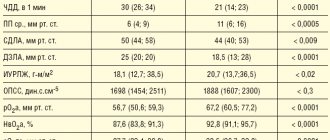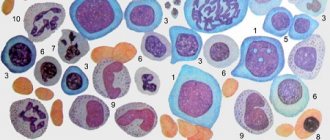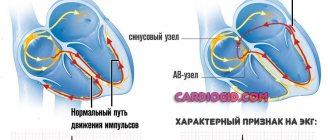What does it mean?
Before talking about indicators, it is worth familiarizing yourself in more detail with the functional definition of such a concept as lower pressure. It would be useful to know why blood pressure is generally measured and recorded in two quantities.
What does the diastolic value show?
When measuring blood pressure, two numbers are displayed on the tonometer screen - one larger, the other several tens smaller. The larger number reflects the value of systolic blood pressure (SBP), which is often called the “upper”, and the smaller number represents the value of diastolic blood pressure (DBP), respectively, the “lower”.
Systolic blood pressure expresses the force with which blood exerts pressure on the arterial wall as the myocardium contracts and blood is released into the arteries. The process is called systole.
When the chambers of the heart expand and blood rushes into them, the diastolic blood pressure value is recorded, the heart muscle is relaxed at this time. The phase of the cardiac cycle in a state of myocardial relaxation is called diastole, this concept formed the basis for the medical name of “lower” pressure.
What is the norm?
To control pressure, it is necessary to compare your own results with normal or reference values. A normal pressure is 120 over 80, and in a wider range – from 100 to 130 mmHg systolic and from 65 to 85 mmHg diastolic. As you can see, the lower pressure we are considering, 90, does not fit into the reference values, which means we need to figure out what the body is signaling with this indicator.
Normal blood pressure by age
What does 90 mmHg mean?
Let's find out what it means when diastolic pressure is at the level of 90 mm Hg, what this tells the doctor. This is the borderline value of DBP, values above which are considered signs of arterial hypertension.
If the lower pressure does not exceed 90, it is considered elevated within acceptable values, and if the diastolic blood pressure is above 90, this indicates the development of hypertension.
Why can values close to 90 mmHg be considered acceptable? The fact is that both upper and lower pressure can periodically rise (up to 90 mm and above) due to the influence of certain external factors:
- excessive consumption of tonic drinks, caffeinated products and alcohol;
- overeating;
- smoking addiction;
- stress, emotional turmoil, intellectual or physical fatigue.
To determine what exactly caused the increase in DBP to 90 mm, you should see a doctor.
A lower pressure reading of 100 mm or higher is a sign of arterial hypertension, even if the upper pressure is not elevated. Situations when only one of the blood pressure values increases is called isolated hypertension.
In most cases, a diastolic blood pressure value of 100 mm or higher is observed with arterial hypertension of II-III degree and indicates a severe course of hypertension. This is more than a good reason for an urgent visit to the doctor and selection of an appropriate treatment regimen.
Possible complications
Constant identification of 90/50 parameters further increases the risk of stroke and cardiogenic shock as a result of prolonged starvation of brain neurons and heart muscle cells.
Primary hypotension with age can lead to the formation of hypertension due to sharp fluctuations in blood pressure, which leads to a decrease in vascular tone.
During pregnancy, hypotension is a risk factor for premature birth and miscarriage.
No ads 3
Reasons why blood pressure is more than 90 mm
If the lower pressure rises to 90 mm Hg. not due to the external factors listed earlier, what other reasons can provoke its jump? Most often, high DBP levels are associated with the following provoking factors:
- hereditary predisposition to certain values of diastolic pressure;
- diseases of the kidneys, heart, thyroid gland, liver and others;
- metabolic disorders;
- disorders of hemostasis (the system for maintaining blood flow);
- long-term use of medications, the secondary effect of which is vasoconstriction (narrowing of blood vessels).
The reasons why diastolic pressure rises to 90 mm and above are numerous; to clarify them, it is necessary to undergo a diagnostic examination.
High lower pressure in a person (90 mm and above) with optimal upper values (less than 140 mm) means the development of isolated diastolic hypertension. This condition poses a serious conundrum for the doctor and a particular concern for the patient, since there are no medications that specifically lower blood pressure alone. Therefore, it is more difficult to treat such conditions than classic hypertension, when the values of upper and lower pressure increase synchronously. But if you follow your doctor’s instructions, it is still possible to stabilize your blood pressure.
If the lower pressure does not exceed 90 mm, and most importantly, the person feels healthy, treatment may not be necessary.
If you follow your doctor's instructions, it is possible to stabilize your blood pressure.
Decrease in parameters in a teenager
Why do teenagers experience low blood pressure? In adolescence, hypotension develops as a result of hormonal changes and non-compliance with the daily routine. Excessive consumption of harmful foods, physical inactivity and prolonged stay in a stuffy room also provoke a decrease in parameters.
Blood pressure parameters of 90/50 in a child under 7 years of age are a variant of the norm
Organic causes of hypotension during puberty:
- disorder of the endocrine glands;
- diseases of the circulatory system;
- diseases of the digestive tract.
What to do to normalize a person’s condition?
Since there are no medications that could reduce the diastolic reading of 90 mm in isolation, it means that we should look for other ways to normalize a person’s condition. The most common causes of vascular disorders are bad habits and an unhealthy lifestyle of the patient, so the main thing that needs to be done to reduce DBP is to eliminate these provoking factors. For many, this will not be an easy task, but if you have a strong desire to gain health, you can try:
- normalize body weight, control the caloric content of food consumed;
- monitor the quality of the foods you eat - exclude fatty (including baked goods with a lot of fat), fried, salty, and too sweet foods from your diet;
- special attention should be paid to salt - its total amount per day should not exceed 5 g (about 1 level teaspoon);
- get rid of harmful attachments - to cigarettes and alcohol, to sweet carbonated waters and snacks;
- monitor the state of the emotional background - in many people, blood pressure reacts extremely sharply to emotional shocks (use “distractions”, meditation);
- avoid mental and physical overstrain (do not take on overtime work, do not increase the load in the training room, etc.).
The gym and optimal physical activity are exactly what you need for vascular health. Without regular exercise, walking or jogging (as agreed with your doctor), it will not be possible to maintain normal vascular tone.
Symptoms
Quite often, when heart pressure rises to 90, a person feels normal or experiences mild discomfort. More significant symptoms appear in the following stages of hypertension.
But sometimes even a slight increase in vascular blood pressure is accompanied by severe symptoms. It includes:
- sudden hot flashes;
- feeling of heaviness in the head;
- heart rhythm failure;
- dizziness;
- insomnia;
- nausea.
If such symptoms occur, any person should check their blood systolic and diastolic pressure (perhaps it has “jumped” significantly - above 90 - and needs to be urgently reduced).
conclusions
- A DBP value of 90 mmHg is the borderline value of diastolic pressure (the upper limit of normal).
- Values exceeding 90 mm in diastolic value are signs of arterial hypertension.
- The condition when the upper blood pressure is below 140 mm and the lower blood pressure is above 90 mm is called isolated diastolic hypertension. There are no medications that have an isolated effect on lower blood pressure.
- In June 2021, the American Heart Association decided on the need to lower the diastolic standard to 80 mmHg. Based on this decision, a value of 90 mm is considered increased pressure and requires reduction.
If the pressure surge occurs suddenly
When diastolic pressure increases, it is important to know the basic principles of first aid. They consist of the following steps:
Advertising:
- The victim needs to take a horizontal position, lie on his stomach face down.
- Place something cold along the cervical spine, ideally ice, this helps reduce pressure. After 30-40 minutes, massage this area to restore blood circulation.
- You can also influence biological points that normalize the functioning of the body. For hypertension, it is worth massaging the points under both earlobes. After this, draw a conditional line from the lobe to the middle of the collarbone. The procedure can be repeated a large number of times until the patient feels better.
Of course, if there is a significant jump in blood pressure, you need to call an ambulance. Due to the pathology that caused diastolic pressure, health may deteriorate even more significantly.
Doctors' opinion
Doctors believe that each person has his own individual blood pressure norm at which he feels comfortable, and which cannot be regarded as a symptom of a particular disease. Moreover, this norm may change with age.
Some people live for years with blood pressure levels that could cause serious illness for others. Therefore, it is not the increase in indicators itself that is dangerous, but the excess of the individual norm.
This means that it is useful for each person to know their individual norm and carefully monitor their well-being. This is especially true for older people.
The need to lower diastolic pressure, which has stopped at 90, arises only when there is a strong impact on the patient’s physical condition. It must be remembered that the main way to reduce such indicators is to eliminate the cause.
This means that before lowering your lower blood pressure, you should undergo an examination and begin comprehensive treatment (or lifestyle changes).
Diagnostics
Blood diastolic pressure of 90 is an important symptom that helps diagnose various diseases. So, if with a reading of ninety the upper pressure is 130 or higher, doctors talk about the potential development of hypertension.
This indicator allows you to determine the efficiency of the heart and the condition of blood vessels. Therefore, during any medical examination, blood pressure is measured.
For the diagnosis of many diseases, the dynamics of blood pressure indicators is important. For this reason, people suffering from various types of chronic diseases are recommended to have a blood pressure monitor at home to regularly measure and record blood pressure levels.
Frequent independent use of a tonometer allows you not only to more accurately diagnose various disorders in the body, but also to respond in a timely manner to your blood pressure if the mercury level rises to 119 or higher.










